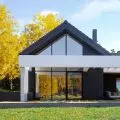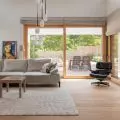Warsaw Uprising Museum
Like the headquarters of the Emigration Museum, the Warsaw Uprising Museum building is not an edifice designed from the beginning with exhibition space in mind. In the past it served as a tramway power plant, and back in the tsarist era there was a factory there. Today, the site is a center of modern patriotism and helps develop national identity and build civic awareness.
Warsaw Uprising Museum
photo: Maja Górczak
Paweł Kowal writes about the Warsaw Uprising Museum as about the place "for grandparents and grandchildren". Significant for the modern viewer is that the permanent exhibition was created sixty years after the outbreak of the uprising, so the narrative perspective of the exhibition differs from that of the uprising. The museum combines the experience of grandparents with the needs of grandchildren. Not only in the exhibition, but also in the architecture.
Warsaw Uprising Museum
Photo: Maja Górczak
The factory buildings are not very photogenic, but they are supposed to be, above all, functional, not beautiful. Perhaps that's also why, at first, it's not immediately clear where the main entrance is, which would be hard to get to if it weren't for a large arrow. After the renovation of the old building, the interior made room for four exhibition levels, a café, a cinema and a chapel. The working-class character was thus completely broken - the sacred supplanted the profane.
The solemnity and thoughtfulness of the architecture of the Warsaw Uprising Museum is also expressed in the design of the space of the areas surrounding the edifice. There is no shortage of a wide square for roll calls and a hill resembling an altar where anniversary field masses are held. The Warsaw Uprising Museum is fenced off by the Wall of Remembrance, on which the names of the fallen insurgents are inscribed. During the holiday season, a wooden footbridge rises above the Wall, leading to the Summer Room, a café-like space where concerts, meetings and lectures about Warsaw are held.
Warsaw Uprising Museum
photo: Maja Górczak
In the activities of Pokoj na Lato, the realization of the "museum for grandparents and grandchildren" concept can again be seen. W nowoczesnej scenerii młodzi ludzie poznają przeszłe czasy i minione opowieści. In pursuing its educational mission, the Warsaw Uprising Museum focuses not only on the cultivation of history, but also educates for patriotism and social responsibility.
POLIN Museum of the History of Polish Jews
Until the opening of the POLIN Museum of the History of Polish Jews, tours from Israel during their visit to Poland stopped mainly in Krakow and Auschwitz. The Association of the Jewish Historical Institute of Poland felt the need to tell a story to a wide audience that would not focus only on the Holocaust and would present the fate of Judaism in Polish lands for more than a thousand years.
POLIN Museum of the History of Polish Jews
photo: Maja Górczak
Thename of the museum - POLIN - is a Polish term that literally translates as "here you will rest." For a nation of eternal wanderers, the Republic was a place where they could stay for a while. In the same way, POLIN is a museum where busy tourists and native Varsovians can find a moment of peace and reflection. Despite its massive size, the building of the Museum of the History of Polish Jews is cozy and does not dominate the buildings of downtown Mokotow too much. The green park surrounding the glass giant actually gives the impression as if it speaks "here you will rest". The entire building is covered with glass panels on which are pasted artistic letters that just form the word Polin. And while Polish-Jewishhistory is not easy, the museum space itself promises to tell the story in a sensitive way, with respect for each side.
POLIN Museum of the History of Polish Jews
photo: Maja Górczak
The interior is filled with brightly undulating walls, protruding outlandish shapes reminiscent of the mountains of sand piled in the Israeli desert or the stagnant water of the Red Sea about to drown the Egyptians. The architect himself - Rainer Mahlamäki - was inclined to this interpretation, but does not impose it on visitors. In this expressive yet calm form, everyone can see a different reference to Jewish culture.
Museum of the History of Polish Jews POLIN
photo: Maja Górczak
The most distinctive part of the building is the shape of its main entrance. The soaring glass portal, curving to the left, resembles a break, a crack in the uniform, monolithic structure of the entire edifice. Such a break in continuity may refer to the tragic history of the Jewish people. However, unlike other museums with similar themes, POLIN is characterized by calm and optimism. Another of the architects in the competition for the headquarters of the Museum of the History of Polish Jews was Daniel Liebeskind, who made a name for himself with the extremely overwhelming and infuriating Jewish Museum in Berlin. His design of the Warsaw museum as an open book was originally touted as the winner. In the end, the Finnish architectural firm that opted to communicate through universal emotions won.
Opposite the museum's main entrance is a spacious plaza, where anniversary ceremonies are held, and a monument to the Ghetto Heroes, by Natan Rapaport. From the front, the western facade of the building is much more interesting and attractive. It features an impressive glazing with a rounded shape, reflecting the Lesmian Meadow and Willy Brandt Square.
The Museum of the History of Polish Jews uses history as a pretext to shape the present and create the future. Its educational and culturalofferings include concerts, meetings with writers and journalists, theatrical performances and dance workshops. POLIN is a testament to how history revitalizes and inspires people of different backgrounds and religions to keep going.
POLIN Museum of the History of Polish Jews
photo: Maja Górczak
History museums attract crowds of visitors of all ages. Some come for the history, others compelled by a school trip, others for the architecture itself. And this is the kind of visiting I would like to invite you to. After all, form also carries content. Therefore, when visiting museums, it is worth looking not only at the internal exhibitions, but also at their external forms.
Maja GÓRCZAK
¹ T. Malkowski,Administrative and reception building of theOpole Village Museum, in Form follows freedom, ed. by J. Purchla and J.Sepioła, Cracow 2015, p. 207.
² M. Arczyńska,European Solidarity Center, in : "Form follows freedom", edited by J. Purchla and J.Sepioła, Krakow 2015, p. 70.
The partner of the competition was Alufire


















































































